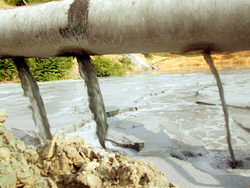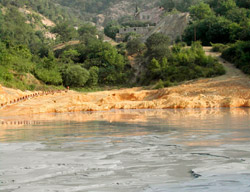
Metal Prince For Sale
Edik Baghdasaryan
Larisa Paremuzyan
A Failed Investment Program
On June 1, the Akhtala Mine Enrichment Plant (AMEP) owned by Metal Prince ltd. closed down.
The plant owners will, in all probability, sell it in the near future to a Russian company owned by an oligarch fromSt. Petersburg. Our source in the mining industry told us that the negotiations had been delayed mainly because of disagreement on the price.
The negotiations are being handled by company president, American-Armenian Serop Der-Boghosian. He has offered a price of US$ 20 million, but the Russian businessman is willing to buy it for only US$ 7 million.
The electricity supply to Metal Prince ltd. has been cut off with effect from June 1 because of accumulated debts, forcing a halt in operations. Around 300 workers have been sent home with the assurances that they will be recalled once everything is settled. When we visited the Akhtala Mine Enrichment Plant on June 16, the doors were locked and sealed. At noon, we met two young guards near the entrance to the plant. The administrative building of the plant was also almost deserted. However, we were told there that the company had not stopped operations in the mines, even though the plant was closed. We also found out at the guard post that Gagik Shahnazaryan, the general director, had come to work. However, it was not possible to find him in the administrative building or anywhere on the territory of the plant, although the company car was parked outside. Mr. Shahnazaryan's secretary ended up in an awkward situation – she pretended to be looking for her boss, but in reality kept trying to interrupt our attempts to get information from the handful of employees in the building. During our conversation with the deputy head of human resources, the secretary sent someone from the cafeteria to tell him that he “was being called to the phone”.
The production director of the company and the head accountant were both absent from work as well. We talked to the latter on the phone and tried to find out the amount of money which made up the debts owed by Metal Prince ltd., but Aram Sokhakyan apologized and said that he could not give us a figure because it was “confidential”.
The company president, Serop Der Boghosian, was not in his office. All the residents of Akhtala who were gathered at the city square knew that Serop Der Boghosian and his wife had left forYerevanon June 1.
Metal Prince enters Armenia
Akhtala has been a copper mining site since the 19 th century. At that time, the mines in Akhtala and Shamlugh were exploited by French companies.Armenia, a Russian region at the time, produced 30 percent of the Russian Empire's copper.
The Akhtala Mine Enrichment Plant and the polymetallic mine closed down in 1988. At the same time, the mines in neighboring Shamlugh shut down as well. The company, consigned to neglect, was plundered over a short period of time. In 1999, after studying the potential for reopening the plant, American-Armenian Serop Der Boghosianregistered Metal Prince as a company in an offshore zone, the British island of Noss, in October 2000. In March of the same year, he had signed a contract for mutual collaboration with the Ministry of Industry and Trade (the company was registered inRomania at the time). In 2001, Metal Prince initiated their program. On November 26, the President attended the official reopening of the AMEP and copper ore production began. The company invested US$ 940,000 and reinstated the Akhtala Mine Enrichment Plant and the Shamlugh mine.
In December of the same year, in an interview with Finance and Economics: Armenia , company president Serop Der Boghosian said, “… we need to start producing 1,200 tons of ore starting June 2002; only then will the company make a profit.”
In the January 2003 issue of the same publication, Serop Der Boghosian said, “AMEP became the property of Metal Prince ltd. in October 2002, a year after it was reopened. In the first phase of the plant's operation, more than 50% of its productivity has been reestablished. Work is in progress and in the second phase, which began with the company's privatization and will last until 2005, 100% of productivity will be reestablished, and we will produce 2–2.2 tons of ore a month… Besides Akhtala, the Armenian government has given us the right to five other mines in the country as well At this point, the mine at Shamlugh has seen the most work done among them, and it has given us the potential to produce 200 tons of ore…”
Over the years, there were reports in different media outlets in the country about this investment program, with particular emphasis on the hundreds of jobs that had been created. The program was also special in that President Robert Kocharyan had visited the company twice and had been part of ceremonies for both phases of the plant's reinstatement. The President really provided support to Serop Der Boghosian as a foreign investor. This may also explain the “tolerance” which the authorities showed towards the AMEP administration, and no state official has had the courage so far to publicly state that this investment program has failed.
On December 25, 2005, in reply to a question about AMEP in the Hotline section of the newspaper Golos Armenii , President Kocharyan said, “The plant is not working rhythmically for one simple reason – there isn't enough ore. The plant has been reinstated, it is in good condition. Now we need investments in the mine.”
The President was saying that the reserves are limited, but it is not clear who has told him that there is little ore. The plant has documents which state that they have secured 37 years worth of ore. Der Boghosian has been making up stories about the reserves in public, which is why the gold mine in Armanis was given to him as well. But nothing was done there for four years. Armanis is, in reality, not utilized as a mine although it has been explored and the reserves have been confirmed.
Metal Prince has a license to extract 100,000 tons a year, but the company president keeps saying that they do not have that many reserves.
One of the specialists working in Akhtala, who naturally wished to remain anonymous, had the following to say about the reasons why the plant stopped operating, “The income is not even covering the cost price of the product. That is to say, all the investment that needs to be done, all the money that needs to be put in – none of it is being done. Let me explain a little further – all equipment used in mining needs to be repaired every two years. If this is not done, the equipment will break down sooner than expected. We have equipment today that should have been fit for use for 10-13 years, but it is already not up to par. It has not been maintained well. There are experts to do this, but no money has been allocated for this purpose. If the plant needs a budget of US$ 100,000-120,000 to operate, then the administration provides only 20% of that. That is why the equipment has broken down.”
In an interview he gave us last year, Serop Der Boghosian said that he had fulfilled his promise to invest US$ 2.7 million. But according to one of his workers, “No mine can produce normally with an investment that is so small. That is why things can never improve here as long as the plant is in the hands of that man. The laborers are to blame too; if they had a decent leader, they could organize themselves better around the issue of this plant.”
The plant's debts
 |
 |
Serop Der Boghosian has not spent any money on environmental conservation, so he has not taken on any “unnecessary” expenses. However, there had been plans to make adequate landfills and to bury wastes appropriately in them.
The profits from the sale of copper are also involved in complicated twists and turns. The AMEP does not sell its product directly, but rather gives it to Metal Prince, who then sells it in the market and transfers a part of the money back to the plant. The rising price of copper in the international market is not having much effect on operations in the plant. It worked at a loss until 2005.
The company owes its staff around 30 million drams in salaries in debts dating back to 2001. According to the company's laborers, the Lori Provincial Court of First Instance in Alaverdi has refused claims from many workers regarding the salary owed to them because they have demanded a statement from the company regarding the amount of monthly salary each worker makes, which the company has refused to provide. The Court of First Instance, rather than force the company to provide that document, has been delaying the legal process for years.
Suren Tamazyan, the mayor of Akhtala, complained, saying that the Akhtala plant “was a bad taxpayer. Irrespective of how business has been for the plant, they have always been irresponsible as far as paying taxes to City Hall goes. I have decided to go to court and demand that Metal Prince pay 12 million drams for 12 years worth of asset tax,” said the mayor.
Tamazyan also noted that the company has not made any contribution to solving the problems of the city, while “the heavy trucks used by the company have ruined the city's roads. Not only has Mr. Der Boghosian not done anything to repair the roads, he hasn't been paying the company's taxes so that we could repair the roads ourselves.”
Metal Prince also has serious problems with the Ministry of Nature Protection. Since operations were restarted (October 2001), the plant has allowed toxic tailings to freely flow through from the reservoir into theDebedRiver. The reservoir today is full to the brim and its concrete walls have cracks.
The plant's laborers have tried to fill those cracks manually, using dried tailings. According to an announcement made by the Arminfo news agency on January 30, 2007, Metal Prince has been called to account on three occasions – the first time they were fined 14 million drams, the second fine was for 40 million drams, and the third time they were summoned to the Environmental Department to provide explanations for their pollution of the Debed River and to assess the environmental situation there.
Serop Der Boghosian had promised to reinforce the reservoir back in 2002.
“We saw a dark colored liquid flowing out of the reservoir and into theDebedRiver. Why are the plant's tailings being cleaned to this day?” When this question was posed to Serop Der Boghosian a year ago, he replied, “Our reservoirs do not pose a threat to nature. We do not use toxic substances which would poison the water and pollute it. Rest assured that there is nothing toxic there; tell me where you think the water is poisonous and I will drink it.”
The laborers are suffering the most as a result of the financial tribulations faced by Metal Prince. For the past few months, the supply of special nutrition provided to the workers, who toil 8 hours a day at the company's mines, has been interrupted. What awaits Metal Prince in the near future remains hard to predict.
 Videos
Videos Photos
Photos




Write a comment